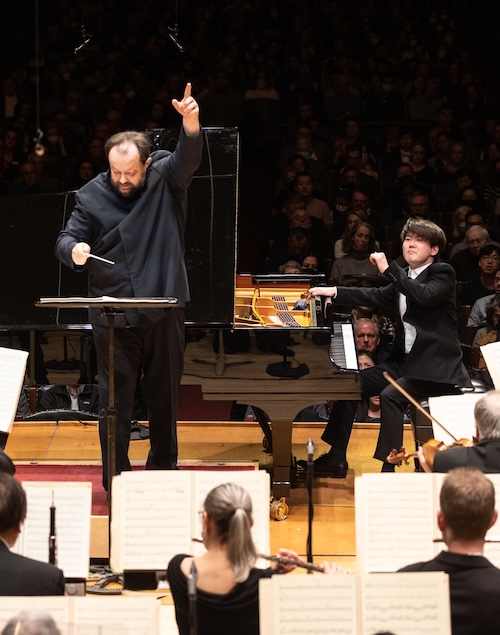Boston Symphony opens a new year with sumptuous Ravel, mostly stirring Stravinsky

Andris Nelsons conducted the Boston Symphony Orchestra in music of Stravinsky, Ravel and Tania León Thursday night at Symphony Hall. Photo: Robert Torres
Nothing draws a crowd like The Rite of Spring. Or, apparently, Seong-Jin Cho.
Together, the combination of Igor Stravinsky’s 1913 homage to pagan Russia and the superstar Korean pianist playing Maurice Ravel’s Concerto for the Left Hand resulted in a full house for the Boston Symphony Orchestra’s first concert of the new year Thursday night..
The hordes at Symphony Hall were as heartening to see as the ensemble’s performance was to hear. Back onstage following a seven-week-long hiatus, the BSO sounded as polished and, generally, secure as ever.
How much the last owed to the night’s program—the Stravinsky and Ravel, plus Tania León’s Stride—is an open question. Regardless, the evening’s selections played to the orchestra’s best strengths as well as, mostly, those of music director Andris Nelsons.
Though the fact wasn’t overemphasized, this month marks the 100th anniversary of the first time the BSO played The Rite of Spring. (On that occasion, it was led by Pierre Monteux, who conducted the work’s notorious world premiere in Paris.) Time may have dulled the score’s ability to shock and offend, but as Nelsons’ reading reminded— sometimes in spite of itself—it remains music of bristling freshness and originality.
The most stirring moments on Thursday came during the Rite’s rhythmically driven, percussion-heavy movements. While the punching accents in “Auguries of Spring” got off to a tepid start, the “Dance of the Earth” pummeled. The “Glorification of the Chosen victim” and “Ritual of the Ancients” were taut. The “Sacrificial Dance” crackled.
Unfortunately, when the score turned lyrical or inward, Nelsons’ interpretation tended to become turgid. “Spring Rounds” plodded. The long grand pause before “Adoration of the Earth” lacked any semblance of tension. Part 2’s “Introduction” and the “Mystical circles of the young girls” felt nearly static.
Yet, despite this, the BSO’s overall performance was admirably balanced and beautifully colored. Surely, Part 1’s “Introduction” can be more clearly defined, structurally, but, for warmth and tonal blend, Thursday’s account was altogether beguiling. So were the viola sextet’s piercingly clear contributions in the “Mystical circles of the young girls.”
And, even though his larger approach wasn’t fully satisfying, one of the benefits of underlining Rite’s mellifluous qualities as Nelsons did was to draw out the score’s debts to older, particularly Russian traditions. Accordingly, the nods to Eastern Orthodox chant in “Summoning of the ancients” spoke clearly, as did the wailing, Tchaikovskian horn licks in the “Mock abduction.”
The conductor was on firmer footing in León’s music. Written for the New York Philharmonic’s commemoration of the centenary of the 19th Amendment in 2019, Stride—which won the Pulitzer Prize in 2021—is a tribute to women’s rights activist Susan B. Anthony.
In the course of its fourteen-minute duration, the score explores a variety of textures and gestures. Some of León’s writing is aleatoric, some not. Though the music’s overarching affect is turbulent and unpredictable, it periodically settles into various grooves: march-like, jazzy, playful, ominous.
Thursday’s first performance captured these strokes well, though the larger picture was hampered by an understandable degree of dynamic tentativeness and ill-defined structure. Still, Stride’s ear-catching episodes—like the extended jazzy bit near the beginning and the flutter-tongued flutes buzzing over tremolo strings near the end—came out well. One anticipates that subsequent performances this weekend will grow in security.
So, no doubt, will Cho’s account of the Ravel, though, on the merits of Thursday’s reading (which was taped for future release by Deutsche Grammophon), it is already an astonishingly mature and confident place. Written for Paul Wittgenstein in 1930, the work’s fiendish technical demands are somewhat obscured by a melodic language that often feels closely related to George Gershwin’s.

Seong-Jin Cho performed Ravel’s Concerto for the Left Hand with the BSO Thursday night. Photo: Robert Torres
At least it did on Thursday. Though the 29-year-old Cho took a few bars to settle into the opening cadenza, once he did, this was a reading of sweep, style, and character.
The opening Lento unfolded with rich, soulful inwardness, Cho’s voicings of the solo line beautifully balanced and fluently shaped. Meantime, he brought swaggering insouciance to the Allegro’s marching episodes and droll atmosphere to its later Bolero allusions. The closing cadenza was dreamy and Chopinesque.
Nelsons drew a rich accompaniment from the BSO. Though there were periodic balance issues with the soloist, the orchestra’s contributions were, by turns, sumptuous, playful, blazing with color, and fully attuned to the spirit of Cho’s performance.
Afterwards, the pianist rewarded a rousing ovation with an encore of Ravel’s Pavane pour une infante défunte. Even more than in the concerto, his playing here (with both hands) was a demonstration of exquisite artistry, breathtakingly attentive to matters of voicing and dynamics.
The program will be repeated Friday at 1:30 p.m. and Saturday at 8 p.m. bso.org
Posted in Performances